You’re investing heavily in marketing—building SEO and content programs, running ads, and boosting brand recognition—but how do you know which touchpoints truly contribute to a sale?
Many businesses can’t answer this question, because they rely on traditional analytics tools, which can only tell them how many visitors clicked an ad or landed on their site and leave them wondering which efforts actually drive revenue.
This is where conversion tracking software comes in handy. The right solution doesn’t just measure clicks and impressions—it connects every touchpoint and every interaction to revenue, helping you maximize your ROI. Not all conversion tracking tools are created equal, though.
In this guide, we’ll break down top the 6 conversion tracking software solutions, covering their key features, benefits, and ideal use cases.
Ready to take control of your marketing performance? Let’s do it!
1. Attribution
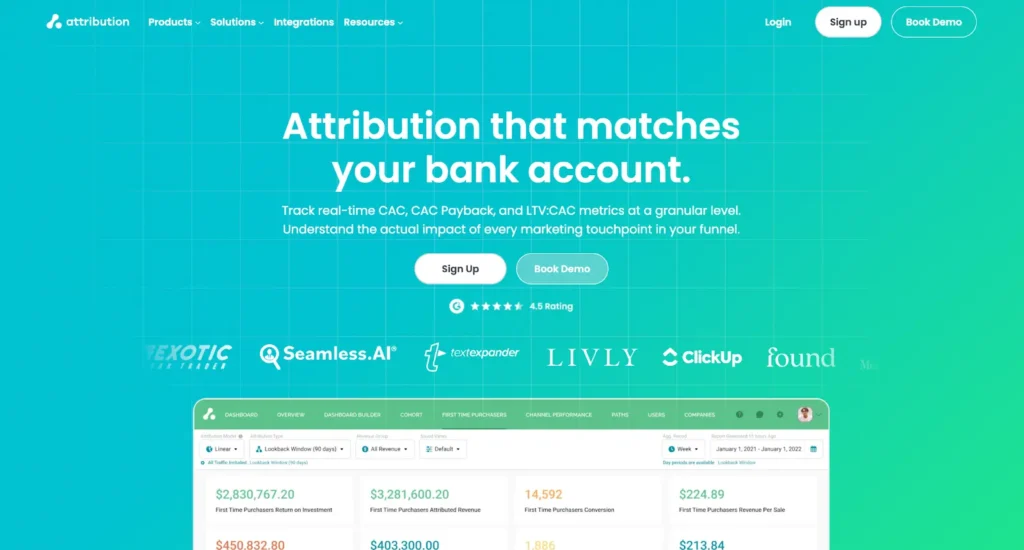
Most marketing analytics platforms promise insights but often leave businesses struggling to connect their efforts to actual revenue. Few tools provide a clear, actionable path to understanding what’s truly driving conversions. Attribution eliminates the guesswork, offering a complete, data-driven view of your marketing impact.
Rather than simply reporting on clicks and impressions, Attribution maps the entire customer journey—from first touch to final sale—so you can see exactly how each interaction influences conversions. It pulls in data from ad platforms, CRMs, and even offline sources, creating a real-time, multi-touch view of which campaigns are generating real revenue.
For businesses committed to optimizing their marketing impact, Attribution is the #1 multi-touch attribution solution that reveals the most effective conversion drivers. Whether you’re a B2B enterprise tracking long sales cycles or an e-commerce brand fine-tuning campaigns for higher ROAS, it helps you scale high-performing marketing efforts and double down on what works.
Key features
- Multi-touch attribution models: Attribution provides one of the most customizable multi-touch attribution solutions available on the market, supporting first-touch, last-touch, linear, data-driven (Markov Chain, Shapley Value), position-based, and custom attribution models. Unlike many other tools that limit flexibility, Attribution allows you to tailor reporting to your unique business needs and accurately track the impact of each touchpoint in the customer journey.
- Real-time channel comparison: Interactive dashboards offer near real-time performance analysis across channels, campaigns, and individual ads. Marketers can quickly identify top-performing channels and areas needing improvement. For instance, a real-time dashboard can display the cost per acquisition (CPA) and return on ad spend (ROAS) for each channel for you to make immediate optimization decisions.
- Automated data collection across platforms: Attribution integrates with leading ad platforms, CRMs, and marketing automation tools to gather performance data, eliminating data silos and providing a holistic understanding of the customer journey. This also reduces manual data entry and ensures that all relevant data is captured accurately.
- Cohort-based analysis: This feature tracks how conversions relate to initial spending over time to provide long-term ROI insights. It helps businesses understand the delayed impact of certain marketing activities, such as content marketing or brand awareness campaigns.
- Privacy-compliant tracking: Attribution is ahead of the curve in this area as It ensures unmatched data accuracy while fully adhering to evolving regulations like GDPR and CCPA. Unlike many attribution tools that struggle with increasing cookie restrictions, it offers advanced cookieless tracking options and differential privacy techniques, maintaining conversion accuracy without sacrificing compliance.
- Deterministic data: To reduce reliance on probabilistic modeling and ensure more reliable attribution insights, Attribution leverages deterministic attribution methods to match user data across devices and channels with high accuracy.
- AI-powered insights: For those looking to proactively optimize their marketing campaigns, Attribution uses machine learning algorithms to identify patterns and predict future outcomes. Its AI capabilities include anomaly detection, predictive modeling (conversion probability), and automated budget allocation recommendations, among others. For example, the platform can identify which customer segments are most likely to convert and recommend targeting strategies to reach them.
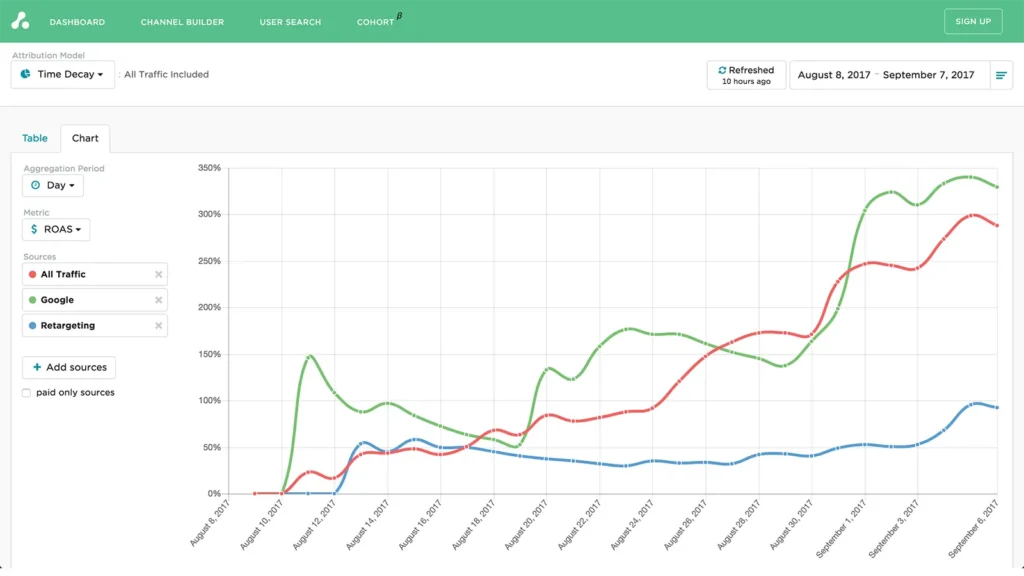
Benefits
- Holistic marketing performance insights: By unifying data from multiple platforms, Attribution gives you a complete picture of how marketing efforts contribute to conversions and revenue so you can make data-driven decisions.
- Reduced reporting workload: Automated tracking and reporting eliminate the need for manual data aggregation and free up marketing teams to focus on strategy rather than spreadsheets.
- Improved stakeholder buy-in: With clear visibility into revenue impact, marketers can easily demonstrate the value of their efforts to leadership, ensuring continued investment in high-performing initiatives.
- Higher ROI and growth opportunities: By accurately attributing conversions across multiple touchpoints, you can identify and scale the most effective strategies leading to sustained revenue growth. For example, ClickUp has scaled from $4M to $150M ARR in 3 years with the help of Attribution.
Ideal for
- B2B companies with complex sales cycles requiring multiple touchpoints and Salesforce attribution to measure marketing’s impact on pipeline and revenue
- E-commerce businesses needing detailed customer journey analysis
- SaaS businesses focused on understanding user behavior and driving conversions
- Marketing teams seeking accurate cross-channel b2b or B2C attribution
- Organizations with significant digital advertising spend requiring optimization
- Companies needing to connect online marketing efforts to offline sales
Looking to understand the full impact of your marketing efforts? Sign up to explore how multi-touch attribution can provide deeper insights into your customer journey.
2. HubSpot

Marketing platforms often struggle to strike the right balance—some are overly complex, while others lack depth for accurate conversion tracking. HubSpot found a sweet spot right in the middle, creating an ecosystem that actually connects the dots between marketing, sales, and customer relationships.
At its core, HubSpot is less of a tool and more of a marketing platform that unifies data and workflows across multiple functions, and makes sure all leads and conversions are properly attributed.
Its real strength lies in enabling a seamless flow of information that many standalone solutions struggle to achieve. For teams focused on inbound marketing, its integrations and automation capabilities can significantly improve how leads are tracked and nurtured.
HubSpot isn’t a magic bullet, though. The most impactful features come with a hefty price tag, and smaller businesses might find themselves paying for capabilities they’ll never fully use. It’s powerful, but you’ll need to be strategic about how you leverage it.
Key features
- Campaign attribution: HubSpot offers multi-touch attribution for campaigns, providing marketers with a comprehensive view of how each touchpoint influences conversions. The AI-powered multi-touch attribution report, available in the Marketing Hub Enterprise tier, enhances attribution capabilities, though it may lack the customizability of dedicated attribution platforms. This feature is best suited for companies deeply invested in the HubSpot ecosystem.
- Forms and landing pages: Marketers can use built-in conversion tools with automatic tracking to capture leads, measure conversion rates, and analyze form submissions for optimization.
- Email marketing tracking: Detailed engagement metrics, including open rates, click-through rates, and conversion rates, help you understand how email campaigns contribute to overall conversions.
- Website analytics: HubSpot tracks visitor behavior and analyzes conversion paths for you to identify which pages, actions, and traffic sources drive users toward completing a desired action.
- Lead scoring: With the help of automated lead scoring, which evaluates conversion-related actions, your sales teams can prioritize leads that are most likely to convert based on engagement and historical data.
- CRM-driven conversion insights: HubSpot’s CRM connects marketing efforts to closed deals, allowing businesses to track conversion rates across the sales funnel and measure the impact of marketing on revenue.
- Marketing automation for conversion tracking: You can step up automated workflows to nurture leads based on their engagement and conversion signals. This way, your potential customers will receive timely, relevant interactions that have the potential to increase conversion rates.
- Social media engagement tracking: While not a dedicated conversion tracking feature, HubSpot allows businesses to monitor how social interactions contribute to conversions by integrating social engagement data with broader marketing analytics.
Benefits
- Accurate campaign performance measurement: HubSpot’s integrated tools enable marketers to track which marketing efforts lead to conversions while assessing the effectiveness of their campaigns.
- Enhanced ROI analysis: By monitoring conversions, HubSpot helps determine the return on investment for various marketing activities, making budget allocation more informed.
- Improved lead attribution: With detailed conversion data, businesses can identify which channels and touchpoints are most effective in driving leads and optimize their marketing strategies accordingly.
- Streamlined conversion path analysis: HubSpot provides insights into the customer journey by highlighting the steps leading to conversions and identifying potential areas for improvement.
Ideal for:
- B2B companies focused on inbound marketing
- Organizations needing combined marketing and sales solutions
- Teams wanting user-friendly conversion tracking
- Companies prioritizing lead nurturing and relationship building
- Small to medium-sized businesses looking for an all-in-one marketing solution
3. Mixpanel
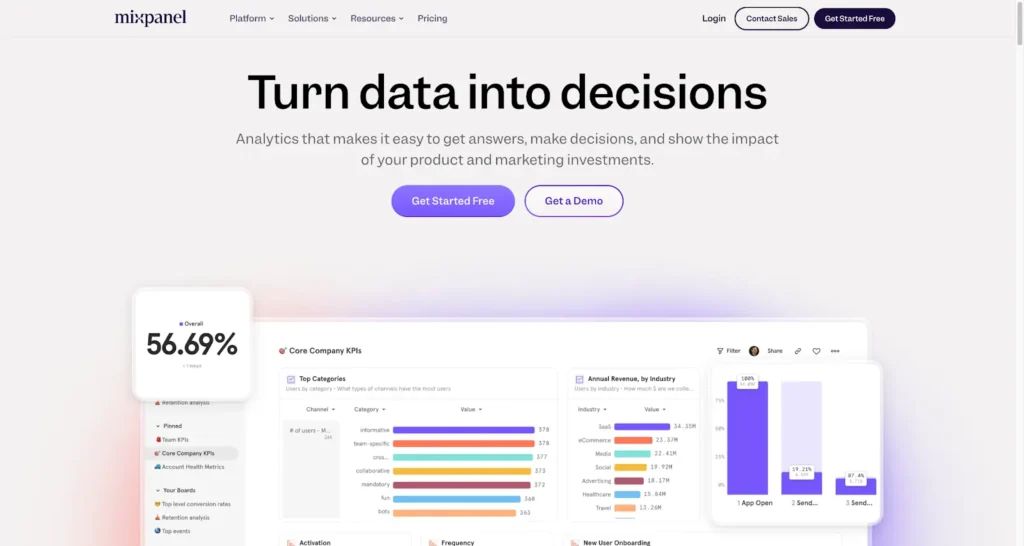
Most marketing analytics tools speak in vanity metrics—clicks and pageviews. Mixpanel speaks the language of user behavior; it turns raw data into a story about how people actually interact with your product.
Built for product and growth teams who want to go beyond surface-level metrics, Mixpanel offers a level of granular tracking that’s almost surgical.
Want to know exactly where users drop off? How different features impact engagement and conversion? Mixpanel helps you understand the why behind user actions.
It’s not a plug-and-play solution, and it’s easy to end up with a mess of unusable data at hand. Setting up Mixpanel requires technical chops and a well-structured data approach, but if you get it right, you’ve got a powerful insights machine at your service.
Key features
- Event tracking: With Mixpanel’s granular monitoring of user interactions, businesses can define and track specific conversion events to understand user behavior leading to conversions.
- Funnel analysis: Visual representations of user journeys help you identify drop-off points within conversion paths and optimize steps to increase conversion rates.
- User segmentation: If you are looking for targeted analysis of different user segments, you can use advanced grouping based on behavior patterns. This will allow you to devise more personalized strategies and ultimately enhance conversions.
- A/B testing: Mixpanel’s Experiments feature analyzes how different variations of your content impact key metrics and can help you decide which changes lead to higher conversion rates.
- Real-time analytics: You can optimize your campaigns in near real-time based on immediate insights into user behavior and conversions.
- Behavioral cohorts: Grouping users based on in-product actions allows for targeted analysis and personalized messaging, improving the likelihood of conversions.
- Impact reporting: Mixpanel quantifies the effect of new features or changes on key metrics and provides data-driven insights into how modifications influence conversion rates.
Benefits
- Data-backed product optimization: By analyzing conversion trends, businesses can refine product features and user flows to reduce friction and improve completion rates.
- Retention-driven conversion analysis: Advanced cohort analysis helps businesses identify patterns in retained and lost users, allowing them to re-engage potential drop-offs before they churn.
- Seamless data integration for conversion tracking: Mixpanel’s API and integrations connect with marketing and analytics tools, ensuring conversion data flows smoothly across platforms.
- Real-time conversion performance monitoring: Dynamic dashboards provide instant insights into conversion events, allowing teams to react quickly to user behavior changes.
- Enhanced user engagement for higher conversions: Personalized insights help businesses fine-tune messaging and user interactions, increasing the likelihood of conversions.
Ideal for
- SaaS companies tracking product usage and conversions
- Mobile app developers needing detailed user analytics
- Product teams focused on optimization and growth
- Organizations requiring detailed user behavior analysis
- Companies with complex user journeys to analyze
- Businesses looking to improve user engagement and retention
4. Kissmetrics
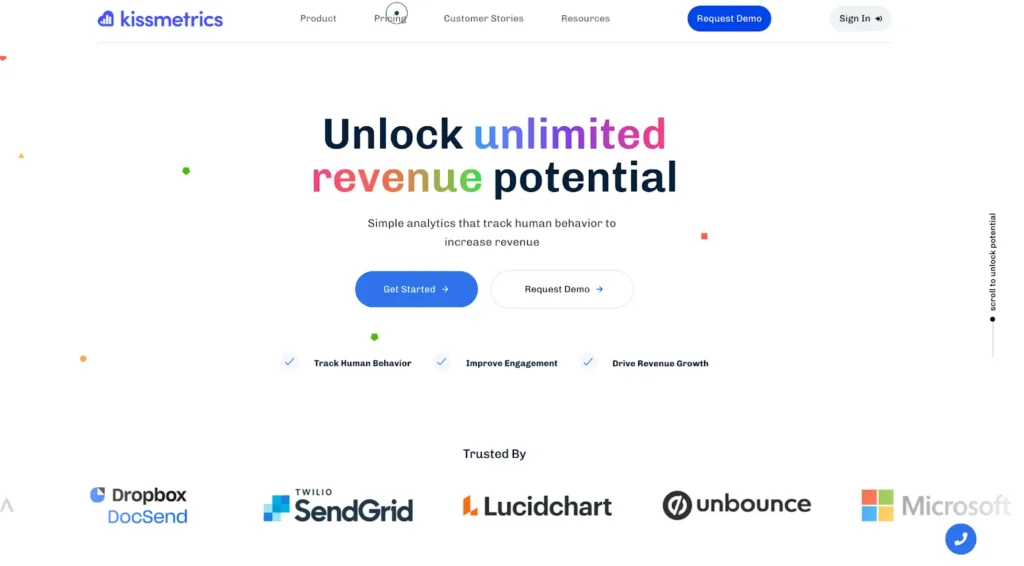
In the world of digital analytics, Kissmetrics takes a bold approach: it tracks users as real people, not just anonymous data points. The platform offers a fresh perspective on understanding customer behavior that goes beyond surface-level metrics to show what truly drives conversions.
Kissmetrics’ standout feature is its person-based tracking technology, which follows individual users across sessions and devices. For businesses with complex conversion paths, this means gaining deep insights into how leads move through their funnels. You’re looking way beyond numbers with this tool—you’re uncovering the story behind each user’s journey.
Kissmetrics isn’t for everyone. While those who want to optimize every stage of their conversion funnel can be drawn to its specialized approach, it will probably feel too granular for others with simpler sales processes.
Key features
- Person-based tracking: To provide a holistic view of individual customer journeys, Kissmetrics maintains user identities across sessions and devices. This continuity is crucial for accurately attributing conversions to specific users, especially for businesses with subscription models or high customer lifetime value.
- Revenue reporting: By directly linking user behavior to revenue outcomes, Kissmetrics enables businesses to understand how specific actions impact their bottom line. This insight is essential for identifying which behaviors lead to conversions and optimizing strategies accordingly.
- Funnel analysis: Kissmetrics offers detailed visualization of conversion funnels, helping businesses identify stages where users drop off. By pinpointing these areas, companies can implement targeted improvements to enhance the user journey and increase conversion rates.
- A/B testing: While Kissmetrics provides built-in capabilities for in-product experiments, its A/B testing features are primarily focused on product-specific variations. For comprehensive marketing experimentation, integrating Kissmetrics with specialized A/B testing platforms is recommended.
- Customer segmentation: Advanced grouping and analysis of customers based on behavior and demographics can help you target specific segments with personalized campaigns. With this targeted approach, you can improve the relevance of marketing efforts and achieve higher conversions.
- Automated reporting: Kissmetrics offers scheduled reports and alerts to provide you with timely insights into marketing performance and enable proactive adjustments to strategies to optimize conversion outcomes.
- Behavioral email triggers: You can tap into automated emails based on user behavior for personalized and timely communication. Engaging users at critical points in their journey helps you effectively guide them toward conversion.
Benefits
- Customer-centric conversion tracking: Kissmetrics provides a detailed view of individual customer journeys to help businesses understand how specific behaviors lead to conversions.
- Revenue-focused attribution: Clear tracking of how marketing efforts contribute to revenue allows you to measure the true impact of your conversion strategies.
- Behavior-driven optimization: Detailed insights into customer behavior and engagement trends can inform new, improved messaging, offers, and experiences to maximize conversions.
- Long-term conversion analysis: By tracking customer lifetime value, you can evaluate the effectiveness of your existing marketing strategies beyond immediate conversions and optimize for long-term growth.
- Seamless integration for conversion insights: Kissmetrics connects with major marketing platforms to ensure that conversion data is unified across all customer touchpoints.
- Enhanced customer engagement for higher conversions: By understanding user behavior and preferences, businesses can create more personalized experiences that boost conversion rates and customer retention.
Ideal for
- E-commerce businesses tracking customer behavior
- SaaS companies monitoring user engagement
- Marketing teams focused on customer journey optimization
- Organizations requiring detailed customer behavior analysis
- Businesses prioritizing customer lifetime value
- Companies seeking to personalize customer experiences
5. Adobe Analytics
Enterprise analytics tools can be difficult to navigate. Adobe Analytics is different. It turns complicated marketing data into clear insights that help large organizations understand their sophisticated conversion paths.
It’s built for organizations that take their conversion tracking seriously—and have the resources to match.
Adobe Analytics goes well beyond basic metrics to connect the dots between marketing efforts and results. It seamlessly blends online and offline conversion data, giving marketing teams the power to understand customer journeys across multiple touchpoints.
With predictive analytics, AI-powered recommendations, and cross-device tracking, marketers can finally see which campaigns truly drive conversions, not just clicks.
Adobe Analytics’ powerful conversion tracking capabilities come with a learning curve that reflects its depth. To harness its full potential, you’ll need dedicated team members, a meaningful budget, and solid technical knowledge.
Key features
- Advanced segmentation: Adobe Analytics offers customizable audience segmentation to help marketers target specific customer groups with personalized campaigns and thus enhance conversions.
- Cross-device analytics: The platform unifies tracking across multiple devices and platforms for you to get a comprehensive view of the customer journey and accurately attribute conversions.
- Predictive analytics: You can tap into AI-powered insights to identify trends and patterns, such as propensity scoring and churn prediction, that can help you optimize strategies for better conversions.
- Custom variables: With extensive customization of tracking parameters, teams can monitor metrics that are most relevant to their goals for improved precision.
- Flow analysis: Adobe Analytics offers visual representations of user navigation paths, if you are looking to understand how users traverse your website or app and identify opportunities to streamline their journey.
- Offline data integration: The ability to incorporate offline conversion data allows for a holistic view of the customer journey, bridging online and offline interactions to provide comprehensive conversion insights.
- Real-time data: You can access near real-time data to swiftly react to changes in user behavior and optimize strategies for improved conversion rates.
Benefits
- Scalability for large-scale conversion tracking: Adobe Analytics processes vast amounts of data across multiple sources, which makes it ideal for enterprises that need to track and optimize conversions at scale.
- Seamless integration for complete conversion visibility: By connecting with other Adobe Experience Cloud products, Adobe Analytics provides a unified view of customer interactions across marketing, sales, and analytics platforms.
- Advanced data visualization for conversion trends: Custom dashboards and interactive reports highlight key conversion metrics and make it easier for teams to analyze trends and identify opportunities for growth.
Ideal for
- Large enterprises with complex marketing ecosystems
- Organizations needing to combine online and offline data
- Businesses seeking advanced analytics capabilities
- Marketing teams looking to optimize their campaigns based on detailed data
- Companies prioritizing data-driven decision-making
6. Supermetrics
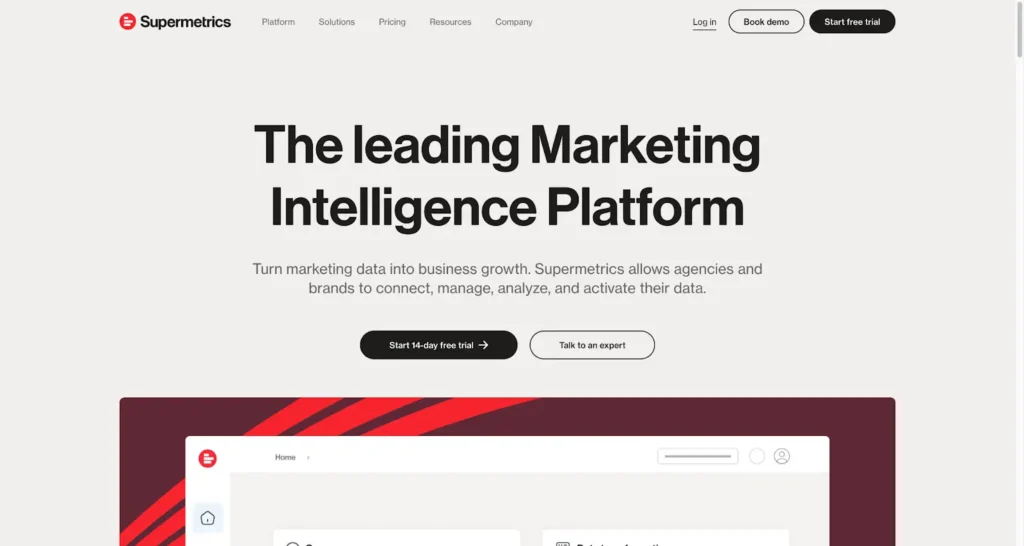
Gathering marketing data from multiple platforms is a headache—especially when trying to track conversions across different channels. Supermetrics simplifies this process by connecting your marketing data from over 100 sources and delivering it where you actually use it.
What makes Supermetrics valuable is how it automates repetitive reporting tasks. Rather than manually updating your marketing dashboards, you can create scheduled data transfers that keep your conversion tracking insights fresh and actionable with minimal effort.
The platform works with your preferred tools—be it Google Sheets or BigQuery—adapting to how your marketing team already operates.
When working with Supermetrics, it’s important to understand its position in your overall marketing stack. While it does excel at collecting and transferring marketing data, it’s not designed for sophisticated analysis on its own. You’ll need additional platforms to fully interpret what the data means and how it can help you boost conversions.
Things to keep in mind: as your marketing sources expand and conversion tracking needs grow more complex, your investment may increase significantly.
Key features
- Data connectors: Supermetrics offers pre-built connectors for over 100 marketing platforms, including Google Ads, Facebook Ads, LinkedIn Ads, and Google Analytics. This extensive integration eliminates the need for manual data extraction and ensures that all relevant data is readily available for comprehensive conversion tracking.
- Data destinations: The platform supports multiple data destinations, such as Google Sheets, Looker Studio (formerly Google Data Studio), Excel, BigQuery, and other data warehouses. You can choose the destination that best suits your reporting needs and makes easier efficient analysis of conversion metrics.
- Automated reporting: Supermetrics automates the process of pulling data from multiple sources and generating reports, which results in significant time savings. This automation ensures that conversion data is consistently updated and readily accessible for timely decision-making.
- Customizable templates: Marketers will find customizable report templates extremely handy when tailoring their reporting to specific needs. This way, they can do a focused analysis of conversion-related data and only highlight performance indicators relevant to their business objectives.
- Scheduled refreshes: Supermetrics provides automatic data refreshes on a scheduled basis, ensuring that reports are always up-to-date. This is crucial for monitoring conversion rates and making informed adjustments to marketing strategies in real time.
- Data transformation: The platform includes data transformation capabilities, allowing businesses to clean, transform, and enrich their data before it is loaded into the destination. It’s a great way of making sure your data is accurate and structured appropriately for analysis.
- API access: Supermetrics offers API access for custom integrations and advanced use cases for businesses to connect the platform with other tools in their marketing stack for seamless data flow and comprehensive tracking of conversion metrics.
Benefits
- Unified data view for conversion tracking: Supermetrics consolidates data from multiple marketing platforms into a single destination to track conversions holistically and gain a complete view of marketing performance.
- Automated reporting for real-time conversion insights: It eliminates the manual effort of pulling data and generating reports and ensures conversion metrics are consistently updated and accessible for timely decision-making.
- Improved data accuracy for reliable conversion measurement: Marketers can pull data directly from source platforms to minimize manual errors and ensure accurate tracking of conversions across marketing channels.
- Flexible reporting for tailored conversion analysis: Supporting multiple data destinations and customizable report templates, Supermetrics allows teams to structure conversion tracking reports based on their unique objectives.
- Scalability for large-scale conversion tracking: The software handles large volumes of data from multiple sources and makes it suitable for businesses of all sizes looking to track and optimize conversions at scale.
Ideal for
- Marketing agencies managing multiple client accounts
- Businesses with complex marketing ecosystems
- Organizations needing to combine data from multiple sources
- Marketing teams willing to automate their reporting processes
- Companies seeking to improve data accuracy and efficiency
Choosing the right conversion tracking software
Summary: Choosing the right conversion tracking software is essential for obtaining accurate ROI data and optimizing marketing performance. Different platforms cater to various business needs: for example, multi-touch B2B attribution (Attribution), inbound marketing tracking (HubSpot), advanced analytics and reporting (Adobe Analytics and Supermetrics), event tracking (Mixpanel), or person-based analytics (Kissmetrics). Selecting the right tool will help you gain a complete, data-driven understanding of what drives conversions.
Key takeaway: Whether you’re seeking enterprise-level analytics, a robust inbound marketing solution, or an all-in-one multi-touch attribution platform like Attribution, the right conversion tracking tool can transform how you measure campaign success. Evaluating the unique strengths of each platform will help you select the most effective tool for your team.
Next step: To make an informed decision, compare the features of the conversion tracking solutions listed above, request demos, and assess how each integrates with your existing tech stack. Consider factors such as real-time data capabilities, ease of use, and scalability. Remember, accurate conversion tracking is essential for driving data-backed growth and maximizing your marketing ROI.
FAQs on conversion tracking software
What is conversion tracking software?
Conversion tracking software records and analyzes key actions users take—such as form submissions, purchases, demo requests, or sign-ups—and attributes them to specific marketing efforts. These tools help businesses understand which campaigns, channels, and touchpoints contribute to conversions, allowing for data-driven decision-making and optimized marketing spend. By integrating with other marketing tools, conversion tracking software ensures that marketers can measure ROI accurately and refine strategies based on real performance data.
How do conversion tracking tools differ from analytics platforms?
While both track user behavior, conversion tracking tools focus specifically on measuring how marketing efforts drive conversions and revenue, whereas general analytics platforms provide a broader view of the overall website or product usage trends.
For example, tools like Attribution assign revenue credit to marketing channels, helping you understand which efforts directly contribute to conversions. In contrast, platforms like Adobe Analytics track page views, bounce rates, and session durations but may not inherently attribute ROI to individual touchpoints. If marketing teams need a clear connection between campaigns and revenue, conversion tracking tools are the better fit.
How does multi-touch attribution improve ROI analysis?
Multi-touch attribution assigns credit to all relevant customer touchpoints instead of giving 100% credit to a single interaction (as in first-touch or last-touch attribution). This approach helps businesses:
- Identify which channels and campaigns contribute most to conversions
- Understand how different marketing efforts work together to influence customer decisions
- Allocate budgets more effectively by investing in high-performing touchpoints
For example, if a lead first engages with a LinkedIn ad, then downloads a whitepaper, and later converts through an email campaign, a multi-touch attribution model will distribute credit across all three interactions—offering a more complete and data-driven picture of what’s driving ROI.
How do I choose the right solution for my business?
Selecting the right conversion tracking software depends on your business goals, tech stack, and team expertise. Here’s what to evaluate:
- Data integration: Ensure the tool connects with your CRM, ad platforms, and analytics stack to get a unified view of conversions.
- Attribution models: Look for software that supports first-touch, last-touch, linear, time-decay, and data-driven attribution to match your analysis needs.
- Reporting and customization: Choose a platform that aligns with your team’s ability to create reports, dashboards, and custom conversion metrics.
- Scalability: If you run high-volume marketing campaigns, opt for a tool that can handle large data sets efficiently.
- Ease of use vs. complexity: Enterprise solutions like Adobe Analytics offer deep customization but require expertise, while platforms like HubSpot provide simpler, more accessible tracking.
If multi-touch attribution is a priority, tools like Attribution can provide clear, auditable insights into how each marketing effort contributes to conversions.
Can I use more than one conversion tracking tool at the same time?
Yes, businesses often use multiple tracking tools for different purposes, but this comes with both advantages and challenges:
Advantages:
- You gain deeper insights by combining ad platform tracking (Google Ads, Facebook Ads) with third-party attribution solutions.
- Cross-checking data can help improve accuracy and reliability.
- You can leverage specialized tools for different conversion tracking needs (e.g., Supermetrics for reporting automation alongside Mixpanel for event-based tracking).
Challenges:
- Different tools may attribute conversions differently, leading to conflicting reports.
- Maintaining multiple platforms requires a strong data strategy to ensure consistent tracking.
- This will result in higher costs and maintenance efforts.
To avoid confusion, you can establish a primary system of record—a tool like Attribution—to serve as the central source of truth, while using secondary tools for deeper channel insights.
